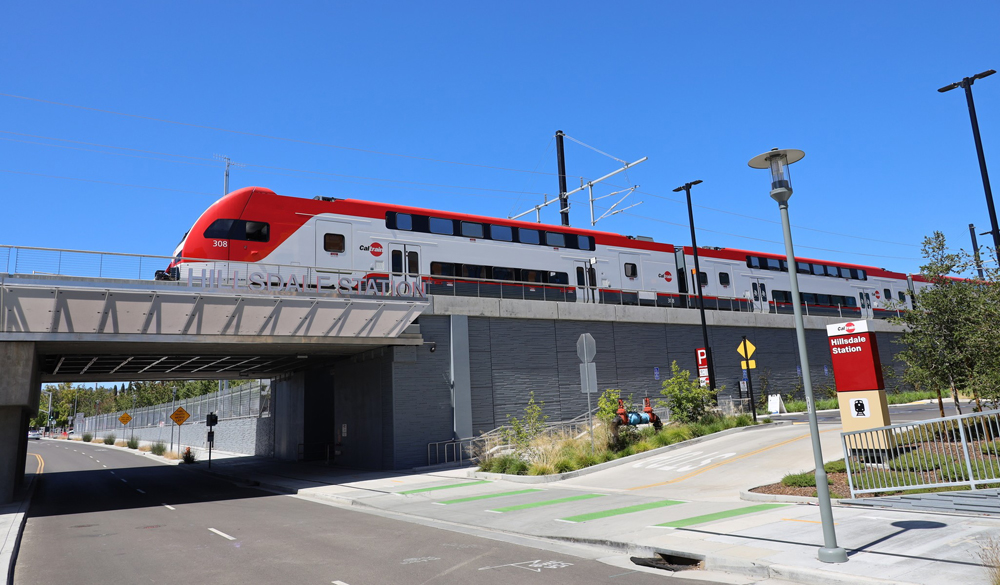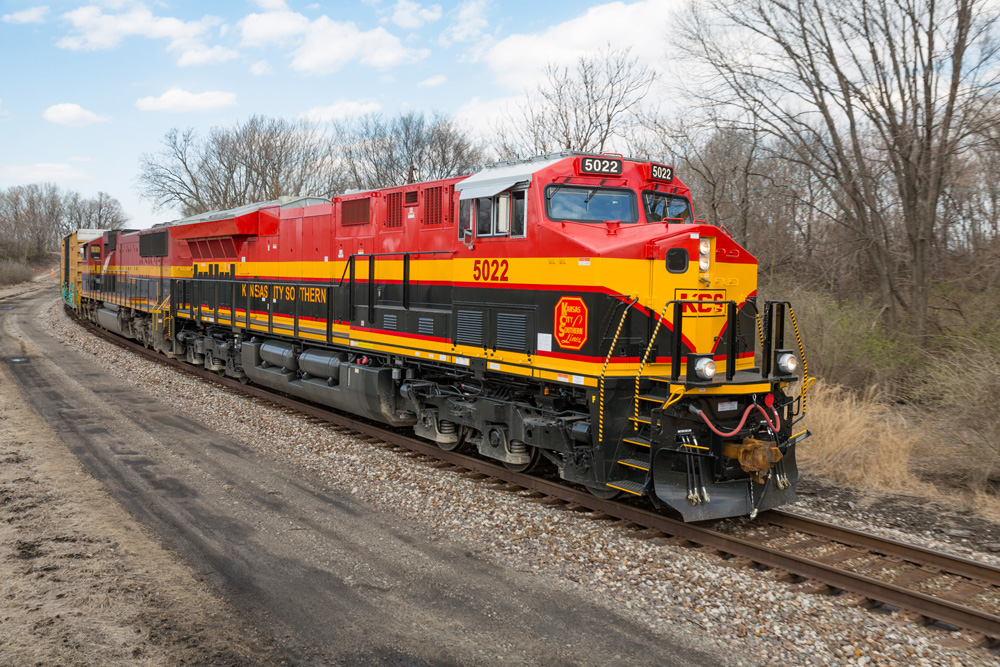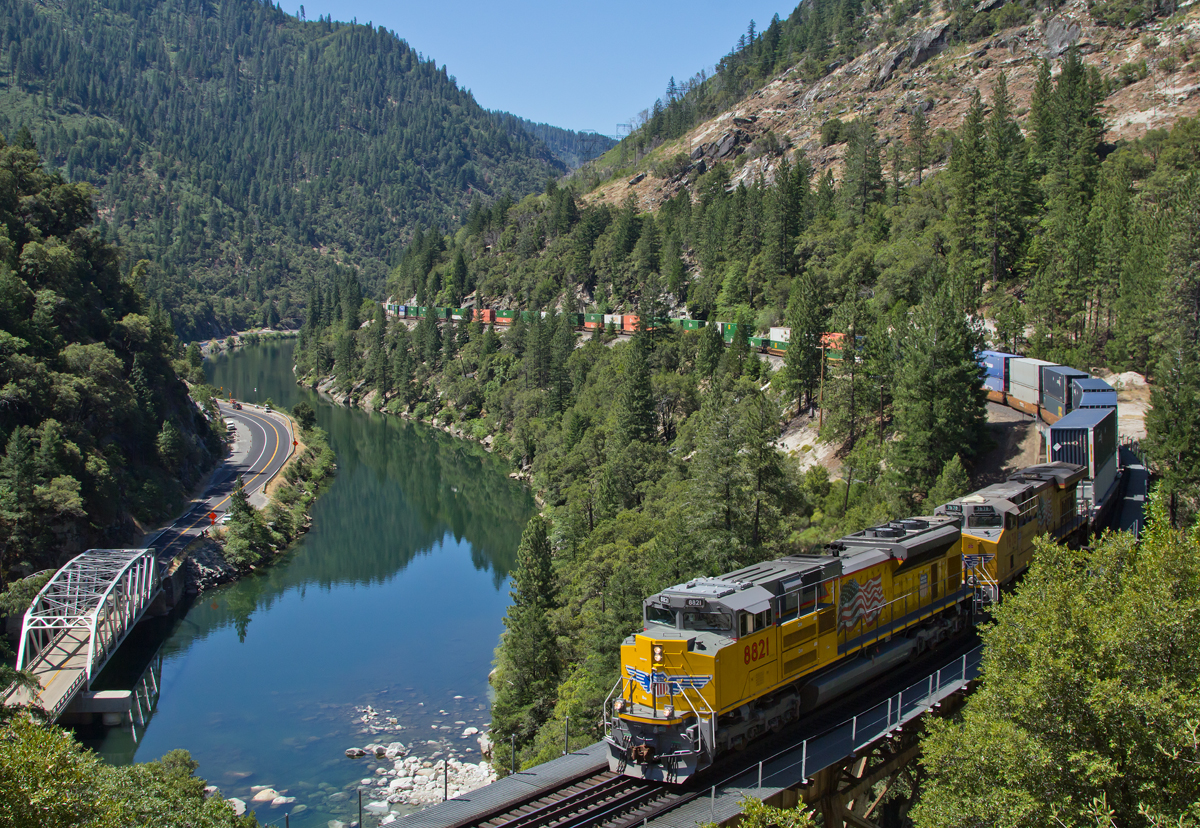
SAN FRANCISCO — Caltrain will begin public operation of its electrified trainsets this Sunday, Aug. 11, the news site SFGate reports.
Agency spokesman Dan Lieberman told SFGate that “a couple” of the electric trains will be in operation, but that Caltrain has decided against announcing which specific trains will be operating with the new equipment to avoid overcrowding for safety reasons and to avoid displacing regular riders. More of the electric trains will be introduced into service each week, he said, until the official switch to full electric service, currently scheduled for Sept. 21.
Work to electrify the 51-mile line between San Francisco and San Jose began in 2017. Stadler USA has built the bilevel trainsets for the electrified service; service plans call for increased frequencies during peak periods and on weekends, and reduced travel times. Overall, electrification will bring a 20% increase in service [see “Caltrain finalizes electrification operating plan,” Trains News Wire, Dec. 12, 2023].














Mr Landey mentioned the idea of the wondering about the idea of regularly commuting the entire length of the route and I agree I would not like to do that either but it would most likely be better than driving that distance every day. Also most of the riders are not end to end but get on or off at the numerus stops between SF and SJ.
Yes, I am suitably impressed with this. Many things were done right. Now, my question is why couldn’t these same train sets be locomotive hauled and used on state supported Amtrak services???? I’m sure there has to be ADA compliance with this equipment.
And they did in in seven years.
Where is Mr. Landey? California was able to deploy a new trainset type without cost overruns and consultant nightmares. Credit where credit is due.
Mr. Landey is suitably impressed.
While on the subject, I’ve always been puzzled by the longer distance commute trains. I have ridden San Jose to SanFran, and to the ends or near the ends of most METRA routes, some MBTA suburban — but only as an occasional visitor, never a daily commuter. Don’t know how people do it. Of course, not all daily riders go end to end, some might ride end to middle, like Wickford Junction (Rhode Island) to Providence, or San Jose to the San Mateo area.
I think it’s worth remembering that San Jose is a significant metro area all on its own, and its population actually exceeds that of San Francisco. Several of the cities just north of San Jose also have significant population and employment centers. So there’s probably quite a few people who are making commutes from places in the middle of the line toward San Jose. I’m hoping to go ride the new Caltrain equipment soon after the full debut in late September. Never did get a chance to ride a gallery car, but I’m not sure that’s missing much.
Messrs. Landey and Bentz are both right to some degree. An important distinction is that the workforce in Santa Clara County (south end of Caltrain) is much more geographically dispersed than in San Francisco. That makes north-to-south commuting more complicated than the other way around. But on a typical workday you’ll find all kinds of trip lengths in both directions, as you both suggest.
Switching to EMU’s and increasing frequency through the day was seen as critical to matching the service pattern the people needed – at least before the pandemic upended everything, and downtown San Francisco’s offices emptied.
@ Mr Landey: When I worked in London one of my co-workers commuted from Birmingham to London daily! That’s a 2.5 hour ride each way. He left Birmingham at 5:40AM and left London to go back around 4:30PM.
I asked him if he had a home life. He said if I had met his wife then I would know why he worked in London. Not sure if he was being cheeky or not, but judging by the number of Anna Kournikova posters hanging around his office, I took him seriously. He said it keeps him motivated to make his train on time.
Fortunately my commute on the Underground was only 15m. When I commuted on Metra in Chicago it was usually 45m to 75m. I always thought commuting to and back from Harvard was too much until I met someone who commuted on Amtrak from Kenosha.
In conjunction with this introduction, San Jose’s Central Coast Railway Club (NRHS Chapter) plans a ‘Farewell to Gallery Cars’ trip on the 10th, but details have not been provided yet on specific trains for the group to ride. After the base system is electric in September, diesel-powered trains with presumably Bombardier cars will still cover the Gilroy service until the Battery EMU set(s) are available in future.
Speaking of electric trainsets, where does Amtrak stand on the new Acela trainsets now sitting useless at many sites? What’s wrong (many items?), what repair/replace steps are being or have been implemented and what is the planned date to commence service? Sounds like a lot of Amtrak senior managers need to be fired and replaced with people who understand real railroading. Heads should roll!
Rarely has Amtrak been run by railroaders.
It is mostly at the hands of government appointed buffoons who love feeding at government trough.
Amtrak never took delivery of the Acela II trains. Alsthom stored them at various points on Amtrak and elsewhere. Since then Alstom changed the spelling of its name and moved the trains.
The good news is Alstom did not run an Acela II train to the Space Station and find they can’t return.
Always look on the bright side of life.